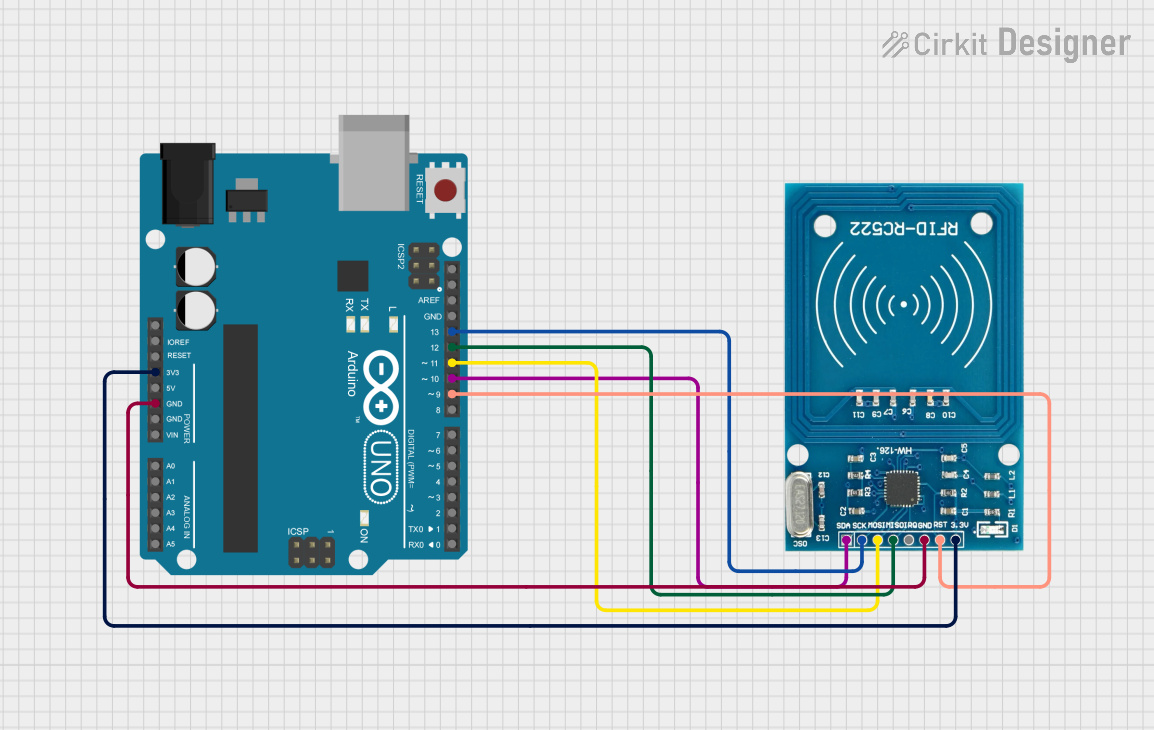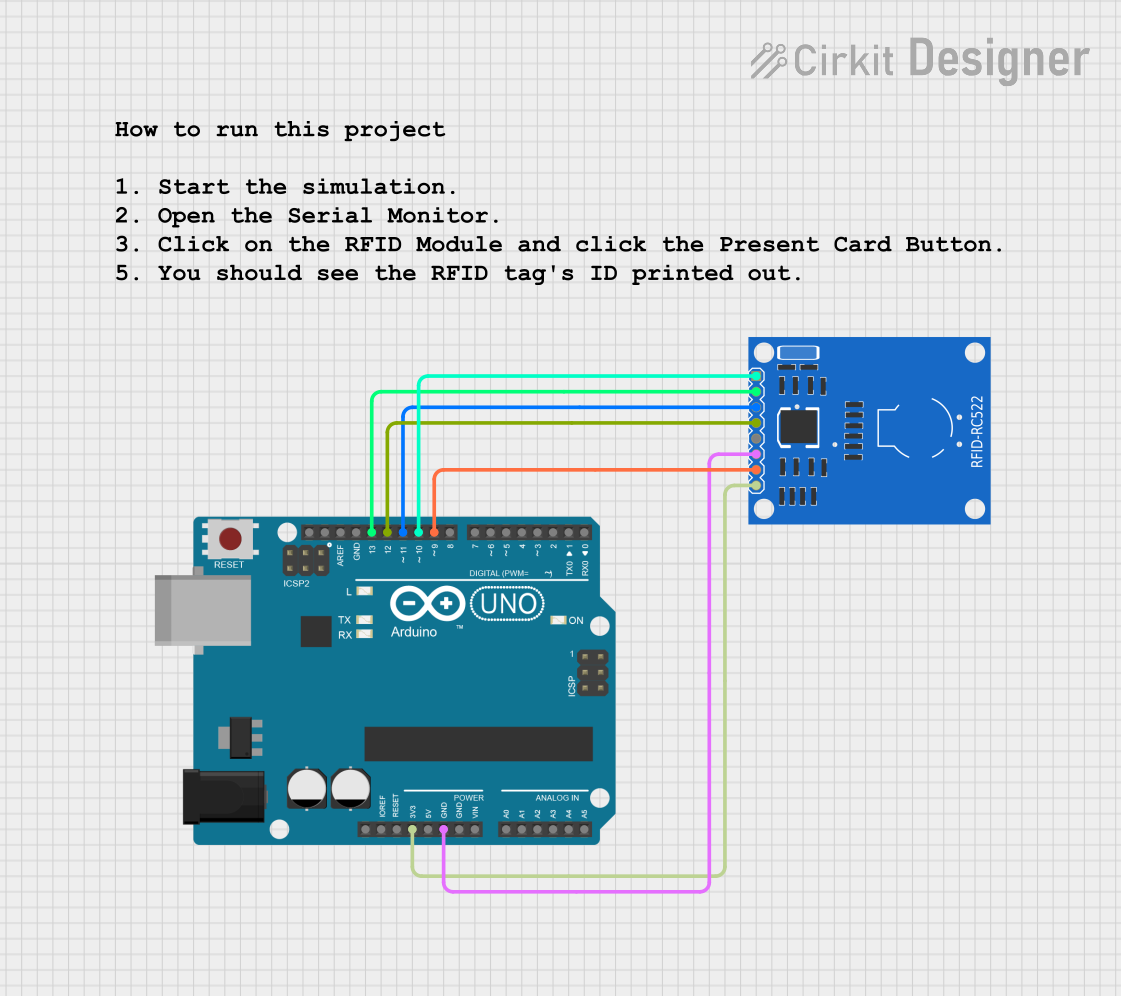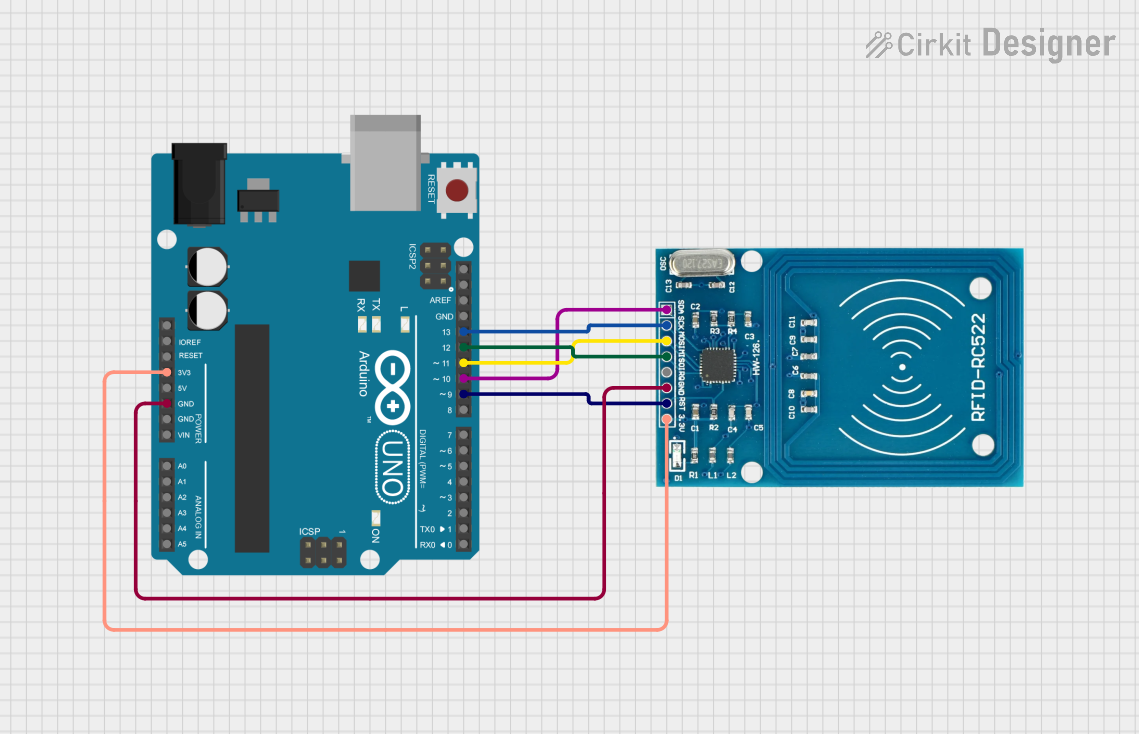
How to Use RC522 RFID Module: Examples, Pinouts, and Specs

 Design with RC522 RFID Module in Cirkit Designer
Design with RC522 RFID Module in Cirkit DesignerIntroduction
The RC522 RFID Module, manufactured by NXP Semiconductors (Part ID: MFRC522), is a compact and cost-effective device designed for reading and writing RFID tags. Operating at a frequency of 13.56 MHz, it supports communication with a variety of RFID tags and cards. This module is widely used in applications such as access control, inventory management, contactless payment systems, and other identification-based systems.
Its small size, low power consumption, and compatibility with microcontrollers like Arduino make it a popular choice for hobbyists and professionals alike.
Explore Projects Built with RC522 RFID Module

 Open Project in Cirkit Designer
Open Project in Cirkit Designer
 Open Project in Cirkit Designer
Open Project in Cirkit Designer
 Open Project in Cirkit Designer
Open Project in Cirkit Designer
 Open Project in Cirkit Designer
Open Project in Cirkit DesignerExplore Projects Built with RC522 RFID Module

 Open Project in Cirkit Designer
Open Project in Cirkit Designer
 Open Project in Cirkit Designer
Open Project in Cirkit Designer
 Open Project in Cirkit Designer
Open Project in Cirkit Designer
 Open Project in Cirkit Designer
Open Project in Cirkit DesignerTechnical Specifications
Below are the key technical details and pin configuration of the RC522 RFID Module:
Key Technical Details
| Parameter | Value |
|---|---|
| Operating Voltage | 2.5V to 3.3V (logic level) |
| Power Supply Voltage | 3.3V |
| Operating Current | 13-26mA |
| Operating Frequency | 13.56 MHz |
| Communication Protocol | SPI, I2C, UART |
| Maximum Data Rate | 10 Mbps (SPI) |
| Reading Distance | Up to 5 cm |
| Dimensions | 40mm x 60mm |
Pin Configuration and Descriptions
The RC522 RFID Module has 8 pins, as described in the table below:
| Pin Name | Pin Number | Description |
|---|---|---|
| VCC | 1 | Power supply input (3.3V). |
| RST | 2 | Reset pin. Used to reset the module. Active LOW. |
| GND | 3 | Ground connection. |
| IRQ | 4 | Interrupt pin. Can be used to signal events to the microcontroller. |
| MISO | 5 | Master-In-Slave-Out (SPI data output). |
| MOSI | 6 | Master-Out-Slave-In (SPI data input). |
| SCK | 7 | Serial Clock (SPI clock input). |
| SDA/SS | 8 | Slave Select (SPI chip select). Also used for I2C communication. |
Usage Instructions
How to Use the RC522 RFID Module in a Circuit
- Power the Module: Connect the
VCCpin to a 3.3V power source and theGNDpin to ground. - Connect to a Microcontroller: Use the SPI interface to connect the module to a microcontroller (e.g., Arduino UNO). The typical connections are:
MISOto Arduino pin 12MOSIto Arduino pin 11SCKto Arduino pin 13SDA/SSto Arduino pin 10RSTto Arduino pin 9
- Install Required Libraries: For Arduino, install the "MFRC522" library from the Arduino IDE Library Manager.
- Write Code: Use the library functions to initialize the module, read RFID tags, and write data to them.
Important Considerations and Best Practices
- Ensure the module is powered with 3.3V. Using 5V may damage the module.
- Keep the RFID tag within 5 cm of the module for reliable reading and writing.
- Avoid placing metal objects near the module, as they can interfere with the RFID signal.
- Use proper pull-up resistors if required for I2C communication.
Example Code for Arduino UNO
Below is an example Arduino sketch to read an RFID tag using the RC522 module:
#include <SPI.h>
#include <MFRC522.h>
// Define RC522 module pins
#define RST_PIN 9 // Reset pin connected to Arduino pin 9
#define SS_PIN 10 // Slave Select pin connected to Arduino pin 10
MFRC522 rfid(SS_PIN, RST_PIN); // Create an instance of the MFRC522 class
void setup() {
Serial.begin(9600); // Initialize serial communication
SPI.begin(); // Initialize SPI bus
rfid.PCD_Init(); // Initialize the RC522 module
Serial.println("Place an RFID tag near the reader...");
}
void loop() {
// Check if an RFID tag is present
if (!rfid.PICC_IsNewCardPresent() || !rfid.PICC_ReadCardSerial()) {
return; // Exit if no tag is detected
}
// Print the UID of the detected tag
Serial.print("Tag UID: ");
for (byte i = 0; i < rfid.uid.size; i++) {
Serial.print(rfid.uid.uidByte[i], HEX); // Print each byte of the UID in HEX
Serial.print(" ");
}
Serial.println();
// Halt the tag to stop further communication
rfid.PICC_HaltA();
}
Troubleshooting and FAQs
Common Issues and Solutions
Module Not Responding
- Cause: Incorrect wiring or power supply.
- Solution: Double-check all connections and ensure the module is powered with 3.3V.
Unable to Read RFID Tags
- Cause: Tag is out of range or incompatible.
- Solution: Ensure the tag is within 5 cm of the module and operates at 13.56 MHz.
Interference from Metal Objects
- Cause: Metal objects near the module can block or distort the RFID signal.
- Solution: Remove any metal objects near the module.
Library Not Found
- Cause: Required library is not installed in the Arduino IDE.
- Solution: Install the "MFRC522" library from the Library Manager.
FAQs
Can the RC522 module write data to RFID tags?
- Yes, the module supports both reading and writing to compatible RFID tags.
What is the maximum range of the RC522 module?
- The module can read tags up to a distance of 5 cm under optimal conditions.
Can the RC522 module work with 5V logic?
- No, the module operates at 3.3V logic. Use a level shifter if connecting to a 5V microcontroller.
What types of RFID tags are compatible with the RC522 module?
- The module is compatible with ISO/IEC 14443 Type A and Type B tags, such as MIFARE cards.